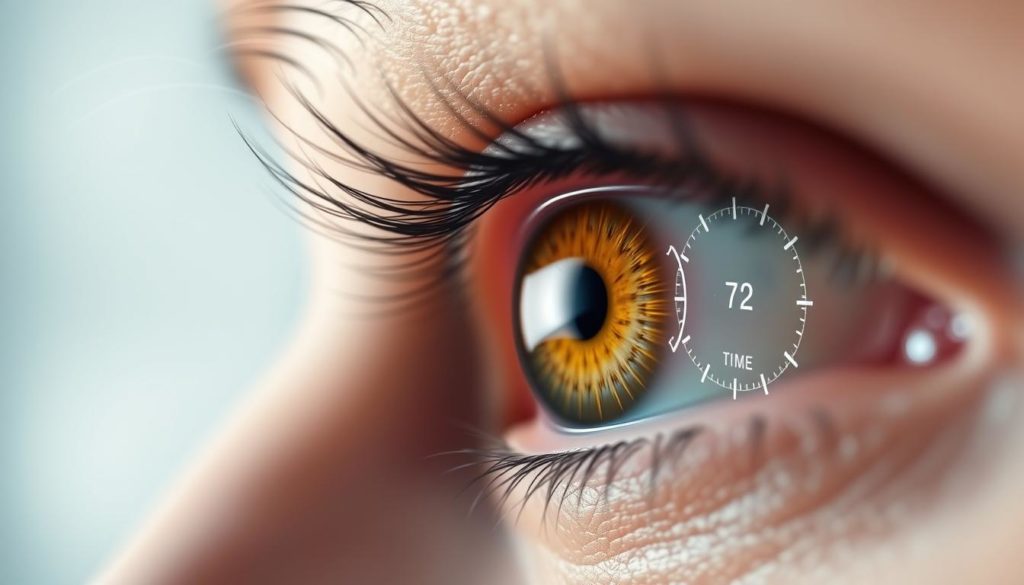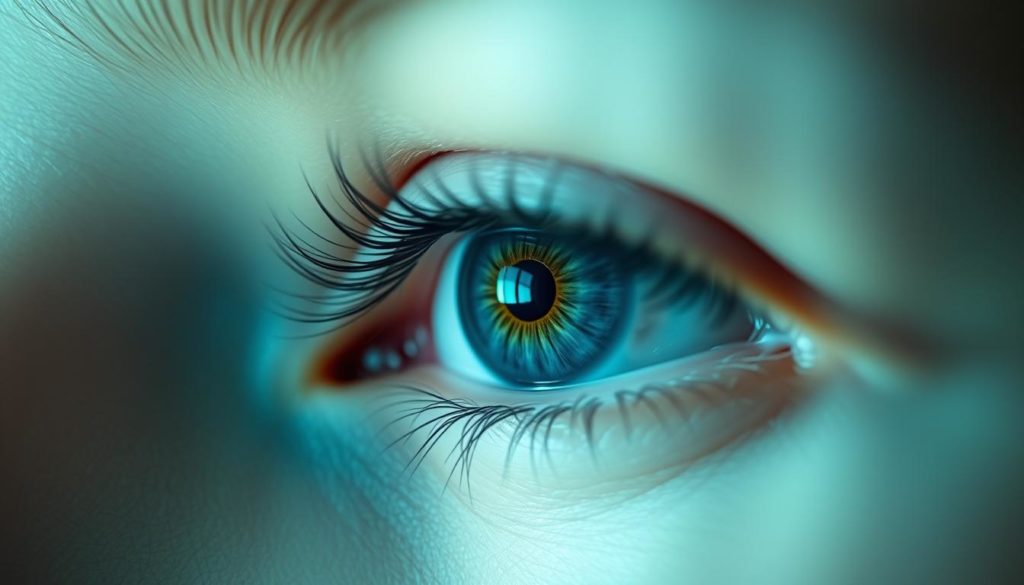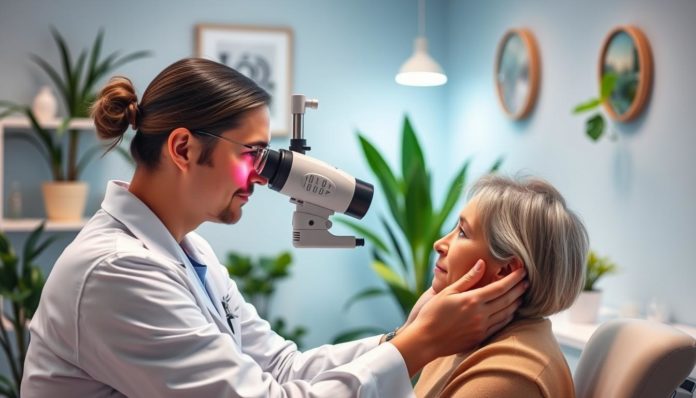Did you know adults typically blink about 15 times a minute? Newborns, in contrast, only blink twice. Most of us hardly notice our blinking. But some have a disorder that makes them blink way too much. This can be unsettling and often signals other issues.
Eye irritation, dryness, or eyelid spasms could cause excessive blinking. It could also be due to vision problems or stress that hasn’t been treated. For both kids and adults, choosing the right treatment is crucial. This helps keep eyes healthy and comfortable. Treatments range from simple eyedrops to addressing stress or vision corrections.
To manage excessive blinking, it’s important to understand what causes it. Keep reading to discover all about these causes and how to treat them.
Understanding Blinking and Its Importance
Blinking happens without us even thinking but can also be done on purpose. It’s vital for keeping our eyes healthy. By understanding blinking fully, we learn its value. We can also find ways to blink well to keep our eyes working their best.
What is Blinking?
Blinking is an important action for our eyelids that helps keep our eyes in good shape. It can happen because we decide to or just by reflex. The main job of blinking is to spread moisture and keep out bad stuff.

Why is Blinking Important?
Blinking does a lot for our eyes. It spreads important nutrients and clears away things that shouldn’t be there. Blinking a lot makes sure we see clearly and keeps our eyes safe from infections. Having the right blinking rate is key to avoid feeling uncomfortable and keeping our eyes healthy.
Types of Blinking: Spontaneous, Voluntary, and Reflex
There are three main types of blinking:
- Spontaneous Blinking: This kind happens on its own, just like how we breathe. It keeps our eyes moist all the time.
- Voluntary Blinking: We do this kind on purpose. Maybe our eyes feel dry or we’re sending a message while talking.
- Reflex Blinking: Bright lights or something flying towards our eyes triggers this blink. It’s our eyes’ way of protecting themselves.
Keeping a steady rate of blinking and using good blinking habits are great for our eyes. They lessen problems caused by not blinking enough.
Normal Blinking Rates and Patterns
Blinking is crucial for eye health. People of different ages blink at different rates. This rate can change due to many things.

Average Blinking Frequency in Different Age Groups
The average blink rate changes as people grow. For example:
- Newborns: Blink about twice a minute
- Teenagers: Blink 12-15 times a minute
- Adults: Blink around 15 times a minute
Factors Influencing Blinking Rates
Several things can change how often people blink:
- Age: Blink rate varies by age.
- Activities: Doing things like reading or using computers can make us blink less. This can cause eye strain or dry eyes.
- Environmental Conditions: Bright lights and big temperature changes can also impact blinking.
Knowing these normal blink rates is important. It helps us notice when something’s not right. This way, we can take care of our eyes better.
Common Causes of Excessive Blinking
Many factors lead to excessive blinking. These can be from physical issues to mental health concerns. Knowing why can help manage lid twitches well.
Eye Irritation and Dryness
Eye irritation is a top reason for blinking too much. Things like dust, harsh chemicals, or eye issues can cause it. Dry eyes from too much screen time also make it worse, as eyes blink more to stay moist.
Vision Problems like Myopia and Hyperopia
Vision issues such as myopia or hyperopia make blinking increase. Struggling to see clearly, eyes work harder. This leads to more blinking.
Environmental Factors and Exposure
Environment affects blinking too. Pollution, allergens, or bright lights irritate eyes. This often increases the blinking without us realizing the cause. It influences how comfortable our eyes are, along with lid twitches management.
Habitual and Stress-Related Causes
Stress and anxiety often cause more blinking. It starts as a small reaction but can turn into a regular habit. Emotional stress makes this worse, turning it into something we do without thinking.
Excessive Blinking in Children vs. Adults
Children and adults show excessive blinking differently, each with unique causes and triggers. Knowing the differences is key for correct diagnosis and treatment.
Causes Common in Children
Several factors lead to excessive blinking in children:
- Refractive errors that need corrective lenses
- Strabismus, which misaligns the eyes
- Environmental changes like sudden exposure to bright lights
- Pink eye or conjunctivitis
Some kids might also start blinking too much around the age of five. This habit usually goes away by itself.
Causes Common in Adults
The reasons adults blink too much are different:
- Eye strain due to prolonged screen time
- Allergies causing eye discomfort
- Dry eye syndrome
- Eye injuries leading to irritation
Stress, fatigue, and anxiety can make both children and adults blink excessively, too. It’s important to understand these causes and how to treat them in each age group.
Excessive Blinking Causes and Treatments
Excessive blinking can happen for many reasons. These range from simple eye strain to complex neurological issues. Knowing the exact cause is key to finding the right treatment.
Common causes include:
- Eye irritation and dryness: Often due to the environment, long screen use, or not blinking enough.
- Vision problems: Myopia or hyperopia can make the eyes blink more as they try to see clearly.
- Habitual behavior and stress: For some, blinking a lot comes from stress or as a habit.
How we treat excessive blinking depends on the cause. Let’s look at some typical treatments.
- Lubricating eye drops: These bring relief from dryness and irritation.
- Corrective lenses: Glasses or contacts can fix vision issues.
- Botulinum toxin injections: These are used for certain eye movement problems.
Seeing an eye specialist is vital. They will help identify the cause of the blinking. Then, they can suggest the best treatment for you.
| Cause | Treatment |
|---|---|
| Dry Eyes | Lubricating Eye Drops |
| Vision Problems | Corrective Lenses |
| Neurological Disorders | Botulinum Toxin Injections |
“Consulting an eye care professional is crucial for diagnosing and treating excessive blinking effectively.”
Diagnosing Excessive Blinking
To accurately address excessive blinking, a diagnosis process is essential. Eye specialists use various diagnostic tools and methods in this thorough evaluation.
Initial Assessment by Eye Specialists
An initial review is key for a blinking disorder diagnosis. Eye specialists examine the eyes’ alignment and movement. They ensure the eyes work together, catching any clear problems or misalignments causing the blink issue.
Using Diagnostic Tools like Slit Lams
Tools like slit lamps are crucial. They let doctors see the eye’s structures in detail, including the cornea. This can show any irritations or issues impacting eye health.
Vision Tests and Refraction Exams
Vision and refraction exams are next. They check how clear the vision is and look for errors like nearsightedness. Finding these errors can lead to treatments, managing the blinking better.
When excessive blinking might signal wider health issues, patients see other specialists. This ensures a thorough approach to their blinking disorder diagnosis.
Eye Health Solutions for Excessive Blinking
Managing excessive blinking can greatly improve comfort and vision. There are many eye health solutions available to help with this issue.
Over-the-Counter Remedies and Eyedrops
Starting with over-the-counter remedies and eyedrops is an easy first step. These products help lubricate the eyes, relieving dryness and irritation. Antihistamine drops are also available to treat eye allergies, which could cause too much blinking.
Prescription Medications and Treatments
In more severe cases, prescription medications may be required. These can treat infections or chronic conditions affecting the eyes. An eye specialist can create a treatment plan just for you.
Importance of Regular Eye Exams
Regular eye exams are key to keeping your eyes healthy. They ensure early detection of any eye conditions. Eye exams update prescriptions and are essential for preventive eye care. Taking this proactive step helps lower the risk of excessive blinking.
| Solution Type | Examples | Purpose |
|---|---|---|
| Over-the-Counter Remedies | Artificial tears, Antihistamine drops | Reduce dryness, Alleviate allergies |
| Prescription Medications | Antibiotics, Specialized eyedrops | Treat infections, Address chronic issues |
| Regular Eye Exams | Annual check-ups | Preventive care, Update prescriptions |
Treatments for Underlying Causes
To deal with excessive blinking, we must look at the root causes. Using the right treatments for involuntary blinking can really help your eyes and make you feel better overall. Let’s explore the treatments that target specific issues.
Managing Eye Irritation and Dryness
First, identify and stay away from things that irritate your eyes. Using warm compresses helps ease the pain from infections. Eye drops and medicines are great for dry eyes and can cut down on blinking.
Corrective Measures for Vision Problems
Issues like nearsightedness or farsightedness often cause blinking. Glasses or contacts can fix these issues. For tough cases, there’s surgery. These methods improve your vision and help with blinking.
Stress and Anxiety Management Techniques
To handle blinking from stress, try relaxing more. Mindfulness, therapy, and relaxation exercises can make a big difference. Keeping up with these methods lowers stress and is good for your eyes.
When Excessive Blinking is a Sign of a Serious Condition
Excessive blinking might seem minor, like from stress or eye irritation. But, it could be a sign of something severe. Finding out why it’s happening is key. It might point to a more serious condition, such as a neurological disorder.
Neurological Disorders Related to Blinking
Some neurological disorders show up with signs like blinking a lot. Diseases like Tourette syndrome or multiple sclerosis have this symptom. They also come with other signs, like muscle twitches or problems moving smoothly. For example, Wilson’s disease impacts the brain and liver and can cause blinking issues. Getting a check-up and tests can help spot any brain trouble linked to blinking.
When to Seek Immediate Medical Attention
Watching how much you blink is important. It’s especially true if there are other worrying signs, like weak muscles, clumsiness, or big headaches. In these cases, getting help fast matters a lot. Checking out Healthline can give you good info on why someone may blink too much and ways to treat it.
Preventive Measures and Lifestyle Changes
To lower how much you blink, it helps to make some changes and take action early. Taking good care of your eyes is crucial for blinking frequency reduction.
A key step is to avoid eye irritants. Stay away from smoke, dust, or windy places that bother your eyes.
Keeping your eyes moist is also important. Eye drops can stop them from getting dry, which often causes too much blinking. It’s good to cut down on how much you look at screens too. When you do, take frequent breaks. Try the 20-20-20 rule: every 20 minutes, look at something 20 feet away for at least 20 seconds.
Lowering stress is important as well. Try yoga, meditation, or deep breathing to calm down. These can lessen blinking that stress brings on.
Wearing glasses that fit your needs is key too. Regular check-ups with your eye doctor can catch and fix problems early. This avoids extra blinking from eye issues.
| Preventive Measure | Benefits |
|---|---|
| Avoiding Eye Irritants | Reduces eye irritation and blinking |
| Using Hydrating Eye Drops | Prevents eye dryness |
| Managing Screen Time | Prevents eye strain |
| Stress Management Techniques | Reduces stress-related blinking |
| Wearing Corrective Eyewear | Prevents vision-related blinking |
| Regular Eye Exams | Early detection of vision issues |
By trying these steps, you can deal with the reasons behind blinking too much. This leads to blinking frequency reduction. Your eyes will stay healthy and feel better.
When to See a Doctor for Excessive Blinking
Experiencing a lot of blinking can be a sign of something more serious. If you find yourself blinking too much, and it’s messing with your day or you have eye pain, lots of tears, quick changes in how well you can see, or swelling, it’s time to check in with a doctor. These signs might mean you have a blinking problem, and getting checked out can make sure it’s nothing worse.
Having your eyes checked regularly is key to keeping them healthy. Catching and treating eye issues early can stop them from getting worse, which might be why you’re blinking so much. Even small things like dry eyes or little irritations are important to take care of so they don’t turn into bigger problems.
If you see changes that don’t go away or if blinking a lot is making life hard, get a doctor’s advice. An eye doctor can look into why you’re blinking so much and help find the right treatment. Getting help early can really make a difference, keeping your eyes healthy and stopping more issues down the line.
FAQ
What causes excessive blinking?
Several things can make you blink too much. These include dry or irritated eyes, eye infections, and lid spasms. Bad vision, brain issues, or stress can also cause it.
How often do people blink on average?
Adults blink about 15 times every minute. Babies only blink about twice. How much you blink can change based on your age, what you’re doing, or where you are.
What is the importance of blinking?
Blinking keeps your eyes wet and clean by spreading tears. It also helps stop infections and keeps your vision clear.
Are there different types of blinking?
Yes, blinking comes in three kinds: spontaneous (automatic), voluntary (on purpose), and reflex (because of something like dust).
What are some common eye health solutions for excessive blinking?
To control blinking too much, you can use wetting eye drops and anti-allergy medicines. Prescribed meds for infections help too. Going for regular eye checks is also important.
What treatments are available for excessive blinking related to stress?
If stress makes you blink a lot, try staying calm with mindfulness, therapy, or relaxation techniques. These methods can help reduce blinking.
How is excessive blinking diagnosed?
An eye doctor will check your eyes closely, sometimes with special tools. They’ll also test your sight and how well your eye focuses to find the cause of the blinking.
What are some preventive measures for excessive blinking?
To prevent too much blinking, avoid things that irritate your eyes. Use wetting drops, limit screen time, reduce stress, wear correct glasses, and get your eyes checked often.
When should you see a doctor for excessive blinking?
See a doctor if you can’t stop blinking, it’s messing with your day, or you have eye pain, goopy eyes, sudden seeing problems, or redness.


